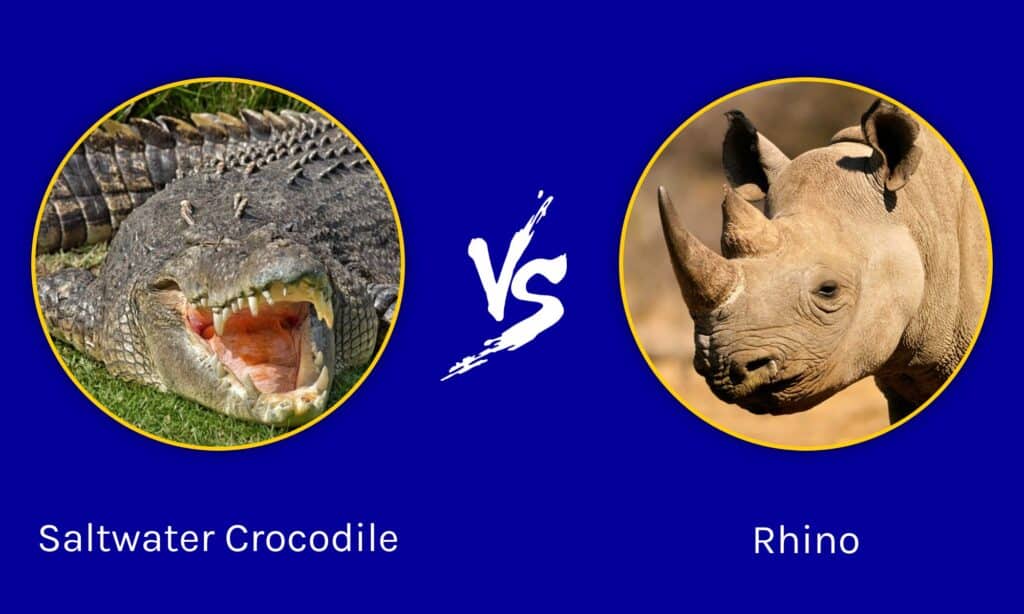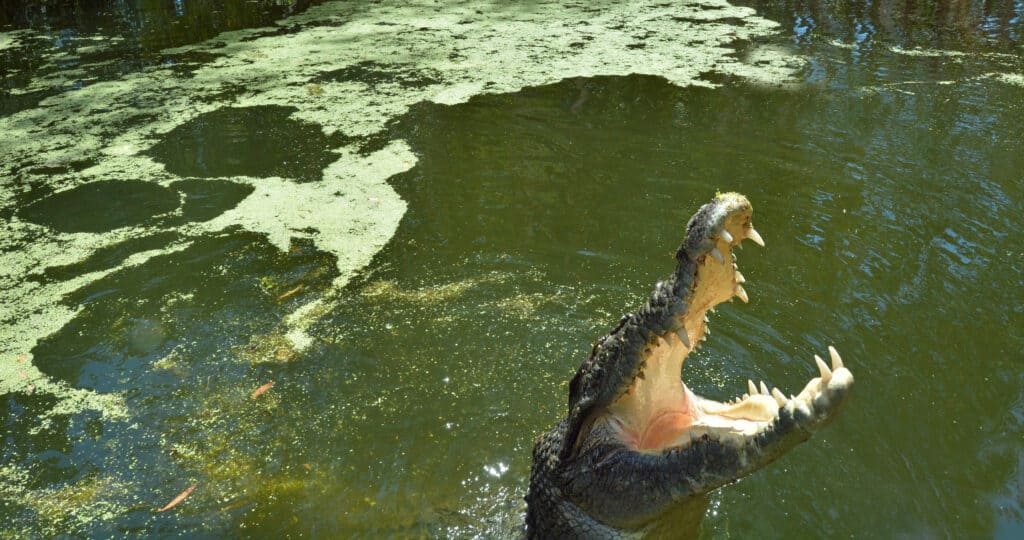Among animals, it is common for epic battles to break out, whether big or small. The most intense battles, however, usually occur between bigger animals. Imagine a battle between a saltwater crocodile and a rhino; which of these animals do you think would win in a fight and why? Let’s find out using available data on both animals, comparing their strengths and other important factors. To that end, we have collected a list of significant physical traits and behaviors that might influence how these two creatures engage in combat. By comparing them, we may determine which animal has the most advantages and the best probability of triumphing in battle.
Comparing a Saltwater Crocodile and a Rhino

| Saltwater Crocodile | Rhino | |
|---|---|---|
| Size | Weight: 440 lbs to 2,200 lbs Length: Can grow up to 23 feet long | Weight: 1,100 lbs to 7,920 lbs Height: 3.3 feet to five feet Length: 6.5 feet to 13 feet |
| Habitat | Swamps, lakes, and river areas | Forests, savannas, and grasslands |
| Appearance | A head that runs into the trunk and ends at the tail | A short tail, short legs, and a cylinder-shaped body. Additionally, some species have a second, smaller horn in addition to the enormous horn in the center of their faces |
| Diet | Carnivore | Herbivore |
| Bite Power and Teeth | 3,700 PSI bite power -66 teeth | 1,000 PSI bite power -24 to 34 teeth |
| Predatory Behavior | Charge towards oncoming predators to scare them away. | Ambush predators that wait in the water for prey to approach. |
What Are the Key Factors in a Fight Between a Saltwater Crocodile and a Rhino?
To figure out what animal would win in a fight, it is beneficial to understand the differences between the animals involved and how these differences might or might not help them in the fight.
The saltwater crocodile and rhino are clearly different animals just by looking at them. The saltwater crocodile is a reptile, whereas the rhino is a mammal; this impacts their morphology, social behavior, and strength. Let’s address some factors that could affect a fight between them one at a time.
Saltwater Crocodile vs Rhino: Size and Speed

The second largest land animal is the rhinoceros.
©iStock.com/PeterVanDam
The largest rhino species, the white rhino, can grow to be 12 to 13 feet long and five to six feet tall and weigh an average of 5,000 lbs, but some have been recorded at 7,000+ lbs. Saltwater crocodiles are the largest type of crocodile. The average saltwater crocodile may reach a length of 17 feet, and even their tails can be as long as seven feet. These crocs can weigh up to 1000 pounds. However, it has been documented that they can reach a length of 23 feet and weigh more than 2200 pounds.
Rhinos can run between 25 to 34 mph, although the speed of a rhino differs according to species. Despite being very big, their legs are strong and fast, and when running at full speed, they run on their toes. On the other hand, saltwater crocs are some of the fastest crocodile species but are not as fast as rhinos. These crocs can run as fast as 15 to 22 mph. Unfortunately, saltwater crocodiles are not as fast as they are in the water, only running a few feet at a stretch on land.
In a fight involving the rhino and the saltie, the rhino would have a size and speed advantage over the croc, and could easily outrun it on land or chase after it if it starts to run away. However, salties are faster in water.
Saltwater Crocodile vs Rhino: Habitat

Coastal waters, mangrove swamps, and rivers are where saltwater crocodiles commonly reside.
©ChameleonsEye/Shutterstock.com
Saltwater crocs can be found in coastal areas from Eastern India to Southeast Asia and Australia. Coastal waters, mangrove swamps, and rivers are where they commonly reside. Additionally, they are able to swim between islands and countries for extended periods of time at sea. Rhinos, on the other hand, are typically found in dense woods and savannas, both of which provide plenty of food and hiding places for them.
Depending on where these animals decide to have their battle, any of them could emerge victorious. If the fight were to happen on land, a rhino might have the upper hand against a saltwater croc because it is more used to living on land. However, if a fight started close to the water or in the water directly, the crocodile would likely defeat the rhino.
However, based on their habitat choices, saltwater crocodiles have an advantage because they can survive on land and in the water, although their ability to survive on land is limited.
Saltwater Crocodile vs Rhino: Predatory Behavior
Saltwater crocodiles are naturally dreadful loners. Unlike other crocodile species that share habitat and even food, saltwater crocs prefer to do everything solo, especially the males. These crocs are also very opportunistic hunters and would attack and eat almost any animal that gets too close while they are hunting. Their preferred hangouts include murky waterways where they can hide beneath the surface. These crocodiles like to conceal their bodies under the water and leave just their eyes and nostrils above the surface, and their skin that camouflages easily helps them stay unnoticed. Saltwater crocs can stay hidden like this for as long as seven hours and would easily attack a rhino if needed.
Rhinos are herbivores, and as such, they do not attack other animals unprovoked. However, these animals have the tendency to be very aggressive and would not hesitate to charge at any animal that provokes them. Also, they are very aggressive when it comes to protecting their young and would attack any animal that goes near them.
Depending on the circumstances of the fight, either animal could have the advantage over the other.
Saltwater Crocodile vs Rhino: Attack Methodology and Defense Mechanism
Saltwater crocodiles are very territorial animals and would defend their territories from intruders at all costs. These crocs are very aggressive and would attack animals and even humans unprovoked in some cases. They have a very thick hide, the ability to hide in murky waters, and the ability to scamper into the water, where they can move quickly and have the advantage in a fight against just about anything.
Of all the animals alive today, saltwater crocodiles have some of the strongest bites. They have 66 teeth that are tailored to help them bite into flesh and hold on with a force of 3,700 PSI. They can drag almost any animal into the sea and drown it or amputate limbs with a rolling maneuver known as a death roll.
Although rhinos are herbivores, they are also aggressive. Despite being herbivores, these animals have powerful jaws with a bite force of up to 1,000 PSI. Also, a rhino’s horn is thick and solid, especially at the base. These horns can grow as long as five feet and are made of keratin.
Saltwater crocodiles have the offensive advantage with more diverse attacks and a stronger bite force.
Saltwater Crocodile vs Rhino: Who Would Win in a Fight?
If a fight were to break out between these two massive animals, it would be a very intense one, but only one can emerge victorious. Because of both animals’ features, the fight would be a pretty close call, but the saltwater crocodile would eventually win. Some of the rhino’s advantages in this fight are its thick skin and hard horn, which are not enough to take on a croc as strong as a saltie. Also, the rhino has the advantage of speed, but in overall strength, the croc has more advantage over the rhino.
The saltwater croc has a strong tail it can use to its advantage. Although its powerful bite might have trouble penetrating the rhino’s skin initially, the skin would eventually give way.
Up Next:
Nile Crocodile vs Saltwater Crocodile: What Are the Differences?
Epic Battles: Saltwater Crocodile vs A Pack of Wolves
Rhino vs. Hippo: Differences & Who Wins in a Fight
The photo featured at the top of this post is © Pius Rino Pungkiawan/Shutterstock.com
Sources
- International Rhino Foundation, Available here: https://rhinos.org/blog/25-things-you-might-not-know-about-rhinos/
- Save the Rhino, Available here: https://www.savetherhino.org/rhino-info/rhino-species/
- Oceana, Available here: https://oceana.org/marine-life/saltwater-crocodile/
Thank you for reading! Have some feedback for us? Contact the AZ Animals editorial team.






